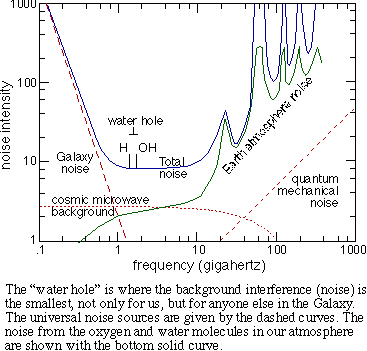
This material (including images) is copyrighted!. See my copyright notice for fair use practices.
The section title is a bit misleading---astronomers are only trying to eavesdrop on conversations already going on. Astronomers are searching for messages carried via electromagnetic radiation (light) because it is the speediest way to send a message. It travels at about 300,000 kilometers/second or about 9.5 trillion kilometers per year (remember that this is equal to one light year?). In particular, the radio band part of the electromagnetic radiation spectrum is searched for messages because radio can get through all of the intervening gas and dust easily. Radio also does not require that much energy to produce it so it should be easier for extraterrestrials to make. The lowest interference from background natural sources is between frequencies of 1 to 20 gigahertz. Our atmosphere narrows this range to 1 to 9 gigahertz. The optimum range is 1 to 2 gigahertz. This is also where the 21-cm line of neutral atomic hydrogen and the slightly smaller wavelength lines of the hydroxide molecule (OH) are found. Because the water molecule H2O is made of one hydrogen atom + one hydroxide molecule, the optimum range to use for our searches is called the water hole.

Complicating the search is the doppler effect. Beings on planets orbiting stars will have their transmissions doppler shifted by ever-changing amounts because of their planet's orbital motion (and the Earth's motion around the Sun). Also, their star is moving with respect to our solar system as they orbit the Galaxy. While radio emission from natural objects (i.e., not from intelligent life technology) is over a wide range of frequencies, radio signals from an extra-terrestrial intelligence are expected to be in a very narrow frequency range, just like the narrow radio frequencies used by human technology because that would be a more energy efficient way to communicate. The radio astronomers must therefore search many different frequency intervals to be sure to pick up the one interval in which the other civilization happens to be at that time. Current searches scan several billion frequency intervals at once, each just 1 Hertz wide.
Detecting an artificial signal above the din and noise of billions of trillions of natural objects and radiation is analogous to picking up trash on the ground. Extra-terrestrial civilizations that want to be detected (or don't worry about being detected) will create things with distinct edges, perfectly consistent curves, and very little color variation. Natural objects usually have fuzzier edges, random curves and bumps, and a spectrum of colors. From a distance one can determine if an object on the ground is popsicle stick or craft stick that should be put in the trash bag instead of a twig from a tree; a bright yellow piece of paper and not a yellow leaf or flower; or a ball bearing instead of a rock, etc.
Another key feature of any signal we intercept is that it must be repeatable---it must be confirmed by others as being extra-terrestrial before any announcement to the press is made. With all of the various sources of radio interference possible, S.E.T.I. scientists want to be sure they have not picked up someone's microwave oven, garage door opener, or one of our satellites, etc. The famous "Wow!" signal of August 15, 1977 in a S.E.T.I. project at Ohio State University was not repeatable. It was a narrowband radio signal that was potentially from beyond Earth but it lasted for only 72 seconds and it has not been detected again.
A message was sent on November 16, 1974 to the globular cluster M 13. Unfortunately, since M 13 is about 25,000 light-years away, we will have to wait about 50,000 years for a reply. Messages have been attached to the Pioneer and Voyager spacecraft, but they will take thousands of years to reach the nearest stars. Our main mode of communication is the inadvertent messages we have been transmitting for several decades now: some of the signal in television and radio broadcasts leaks out to space and rushes outward at the speed of light. It takes many years for the radio and television signals to reach the nearest stars because of the great distances to even the nearest stars. So perhaps radio astronomers on other planets are watching the original broadcasts of ``Gilligan's Island'' or ``Three's Company'' and are seriously reconsidering their decision to say hello (message for network legal department: that is a facetious statement and is not to be taken as a serious statement about the quality of your clients' product). We are currently in a major technology switch-over between television/radio broadcasts (over the air to cable) and telephone communication (land-line to cellular) that does affect how much noise and the type of noise we are making.
Artificial things could also have a distinct temporal edge as well---a signal that is suddenly on and then suddenly off, instead of ramping up in brightness and then fading away over an extended time. Some searches for extraterrestrial signals are looking for very brief (nanosecond) optical (visible light) flashes because visible light can travel great distances out of the galactic plane and a tightly-focused beam of light (like a laser) can made to be many times brighter than a star (for very brief pulses just a nanosecond long). If the beam of light is pointed our way, we could see it over the glare of the star the extraterrestrials orbit. Also, the higher frequencies of visible light than radio means that a larger amount of information could be transmitted in a given amount of time than with radio. Perhaps the extraterrestrials would use radio signals to make their presence known and use lasers to beam information to us once we have started looking their direction.
![]() Go back to previous section --
Go back to previous section --
![]() Go to next section
Go to next section
last updated: August 5, 2022